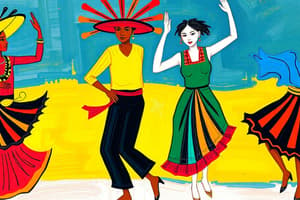Podcast
Questions and Answers
What was the historical view of Physical Education?
What was the historical view of Physical Education?
Education of the physical body with a focus on muscle strengthening.
What does 'education through movement' emphasize?
What does 'education through movement' emphasize?
Holistic development through physical activities.
The focus of modern Physical Education in the Philippines is only on physical fitness.
The focus of modern Physical Education in the Philippines is only on physical fitness.
False
Which of the following are benefits of movement in education as outlined by Wunderlich? (Select all that apply)
Which of the following are benefits of movement in education as outlined by Wunderlich? (Select all that apply)
Signup and view all the answers
What is the main goal of Physical Education as stated in the document?
What is the main goal of Physical Education as stated in the document?
Signup and view all the answers
Which of the following legal bases established Physical Education in Philippine schools? (Select all that apply)
Which of the following legal bases established Physical Education in Philippine schools? (Select all that apply)
Signup and view all the answers
Study Notes
Definition and Historical Context of Physical Education
- Physical Education (PE) in Philippine schools has evolved from focusing on the development of a muscular physique to a broader educational perspective.
- Historically, activities included "drill," "physical training," and "calisthenics," aimed primarily at muscle strengthening.
- Contemporary PE emphasizes "education through movement," promoting holistic development rather than just physical fitness.
Benefits of Movement in Education
- Movement provides essential sensory data and broadens perspectives for learners.
- Engaging in physical activities stimulates the function and structure of bodily organs.
- Individuals learn about themselves and their environment through movement experiences.
Modern Approaches to Physical Education
- The "learn to move, move to learn" philosophy highlights the importance of mastering movement for effective learning.
- Diverse activities such as games, dance, gymnastics, athletic sports, and outdoor pursuits serve as mediums for achieving educational outcomes.
- PE aims to develop various competencies beyond fitness, including social skills, teamwork, leadership, and emotional well-being.
Objectives and Functions of Physical Education
- PE is integral to the educational program, fostering physical, social, emotional, and mental development through selected physical activities.
- Education through physical exertion enhances the teaching and learning of essential skills and attitudes.
Legal Foundations of Physical Education in the Philippines
- 1901: Inclusion of physical exercise in public school subjects and establishment of regular athletic programs.
- 1920: Mandated Physical Education as a required subject in all public schools.
- 1937: Formal incorporation of PE as a subject in secondary school curricula.
-
1969: Introduction of the School of Physical Education and Sports Development Act, which established various activity programs:
- Health education and nutrition programs.
- Physical fitness programs for all students.
- Competitive athletics programs.
- Intramurals and inter-unit athletic competitions within schools, districts, and provinces.
Studying That Suits You
Use AI to generate personalized quizzes and flashcards to suit your learning preferences.
Description
Explore the evolving definition, goals, objectives, and functions of Physical Education in Philippine schools. This quiz takes you through historical perspectives and contemporary views on physical education and its significance in education. Test your knowledge on the transformations in physical education practices over time.




